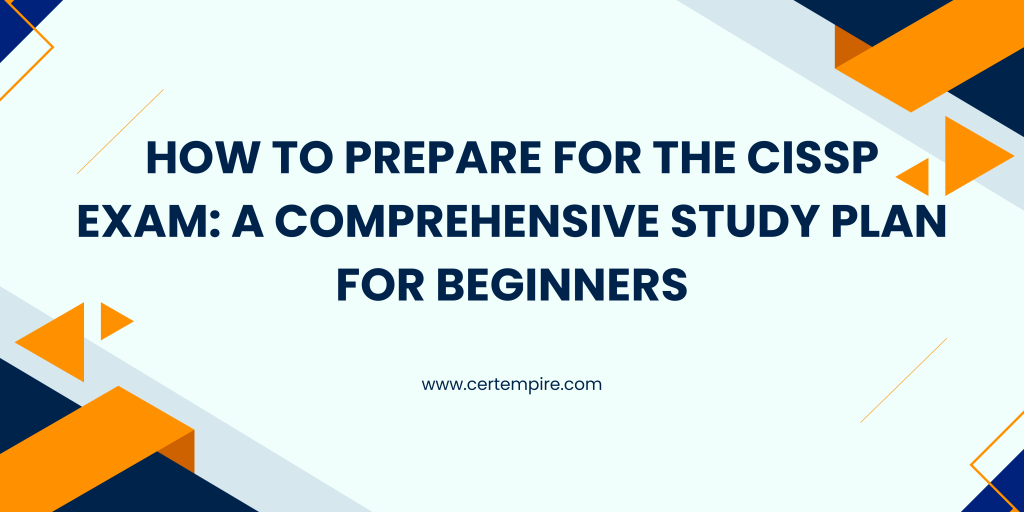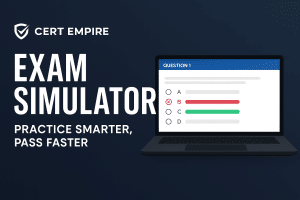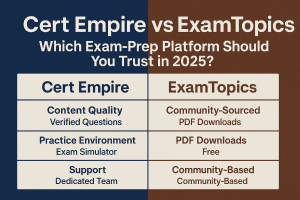The Certified Information Systems Security Professional (CISSP) certification is one of the most respected and valuable credentials in the cybersecurity field. However, preparing for this advanced exam can be a daunting task, especially if you’re new to the certification or cybersecurity in general. With its wide range of topics and complex material, it’s essential to have a solid, structured study plan in place.
In this blog, we’ll guide you through a comprehensive study plan to help you prepare for the CISSP exam, specifically tailored for beginners. Whether you’re starting from scratch or have some experience in the cybersecurity field, this step-by-step guide will ensure you’re ready to succeed on exam day.
TLDR: Too Long; Didn’t Read
Preparing for the CISSP exam can be overwhelming, but with the right study plan, it becomes manageable. Beginners should focus on building a solid foundation, studying one domain at a time, and using various study resources, including study guides, practice exams, and CISSP video courses. A study plan spanning 4-6 months is recommended, with consistent revision and practice.
Why a Study Plan is Essential for CISSP Success
The CISSP exam covers a broad range of topics, divided into eight domains. With such a vast amount of material, it’s easy to feel overwhelmed without a clear, structured study plan. A well-organized study plan will not only help you stay on track but also give you the confidence to tackle the exam head-on.
A study plan ensures that:
- You stay focused on the most critical areas of the exam.
- You have enough time to review difficult concepts and reinforce your understanding.
- You are consistently practicing with CISSP exam simulators and practice questions.
Month-by-Month CISSP Study Schedule (Beginner Plan)
| Month | Key Tasks | Suggested Hours | Goal |
| 1 | Read ISC2 Official Study Guide; build glossary of key security terms | 30–40 | Strong foundation in core concepts |
| 2 | Deep dive into Security & Risk Management and Asset Security; take domain quizzes | 35–45 | Master first two domains |
| 3 | Study Security Architecture, Communication & Network Security; practice with short timed tests | 35–45 | Cover mid-weight domains |
| 4 | Cover IAM, Security Assessment & Testing; begin full-length practice exams | 30–40 | Identify and improve weak spots |
| 5 | Focus on Security Operations and Software Development Security; revise flashcards | 25–35 | Complete all eight domains |
| 6 | Weekly timed exams; review mistakes; light reading of frameworks (ISO, NIST) | 20–30 | Exam-readiness and confidence |
Step 1: Assess Your Current Knowledge
Before diving into your study plan, assess your current knowledge and experience in cybersecurity. This will help you understand where you stand and highlight areas where you need more focus.
Questions to Ask Yourself:
- How familiar am I with cybersecurity principles, such as risk management, network security, and identity management?
- Which CISSP domains do I feel most confident in, and which ones do I need to spend more time on?
- Have I already worked in roles related to the CISSP domains?
Why This Step Matters:
Understanding your baseline knowledge will help you allocate more study time to areas where you’re less confident, ensuring a more efficient and effective preparation process.
Step 2: Set a Realistic Timeline
A common recommendation is to study for 4-6 months before attempting the CISSP exam, especially if you’re new to the material. Depending on how much time you can dedicate to studying each week, you may need to adjust this timeline.
Study Time Estimate:
- Beginner: 4-6 months (around 10-15 hours per week).
- Intermediate: 2-4 months (around 10-12 hours per week).
Why This Step Matters:
Setting a realistic timeline helps you avoid the stress of cramming and ensures that you can digest the material over time without feeling rushed.
Step 3: Break Down the CISSP Domains
The CISSP exam covers eight domains, each representing a key area of knowledge in information security. Here’s a breakdown of each domain and the percentage weight in the exam:
- Security and Risk Management (16%)
- Asset Security (10%)
- Security Architecture and Engineering (13%)
- Communication and Network Security (13%)
- Identity and Access Management (IAM) (13%)
- Security Assessment and Testing (12%)
- Security Operations (13%)
- Software Development Security (10%)
Why This Step Matters:
Understanding the weight of each domain allows you to prioritize your study efforts. Focus more on high-weight domains like Security and Risk Management and Identity and Access Management, but don’t neglect the other domains.
Step 4: Gather Study Materials
To succeed in the CISSP exam, it’s important to use a variety of study resources. Here’s a list of materials that will support your study plan:
Essential Study Materials:
- CISSP Official Study Guide: This book provides a thorough review of all eight domains.
- Practice Exams: Use CISSP practice exams to familiarize yourself with the question format and identify weak areas.
- CISSP Video Courses: Video-based training is excellent for visual learners and helps reinforce key concepts.
- Flashcards: These are great for memorizing key terms, concepts, and definitions.
- Online Communities and Forums: Join CISSP study groups (e.g., Reddit, LinkedIn) for additional tips and support.
Why This Step Matters:
Using a combination of study materials will provide you with diverse learning methods and help reinforce your understanding. Videos, books, and practice exams each contribute differently to your exam preparation.
Step 5: Follow a Structured Study Plan
Now that you have all the materials, it’s time to dive into your study plan. We recommend studying one domain at a time. Here’s an example of a 4-month study plan:
Month 1: Foundation Building
- Focus: Security and Risk Management and Asset Security.
- Activities: Read the chapters, watch videos, and take chapter quizzes.
- Practice: Take small practice tests after completing each domain.
Month 2-3: Deep Dive into Remaining Domains
- Focus: Security Architecture and Engineering, Communication and Network Security, IAM, and Security Assessment and Testing.
- Activities: Review your notes, watch videos, and take practice quizzes.
- Practice: Use practice exams to simulate real exam conditions.
Month 4: Revision and Final Preparation
- Focus: Review the high-weight domains: Security and Risk Management, IAM, and Security Operations.
- Activities: Revisit difficult topics, and revise using flashcards and notes.
- Practice: Take full-length practice exams and focus on time management.
Why This Step Matters:
Following a structured study plan helps break down the material into manageable chunks. It ensures that you’re consistently covering each domain and reinforcing your knowledge over time.
Step 6: Practice, Practice, Practice
One of the most important aspects of CISSP preparation is practicing with real-style exam questions. Use practice exams to simulate the exam environment and get familiar with the question formats, especially multiple-choice, drag-and-drop, and hotspot questions.
Why This Step Matters:
Practice exams help you understand the exam’s format, reinforce your knowledge, and build your confidence. They also help you identify areas where you need further study and time management practice.
Step 7: Take Care of Yourself
The CISSP exam is challenging, and maintaining a balanced lifestyle during your preparation is essential. Get enough sleep, eat healthily, and take breaks to ensure you stay energized and focused.
Why This Step Matters:
Taking care of your mental and physical health will allow you to stay sharp and focused during your studies. Avoid burnout by staying consistent but not overwhelming yourself.
Recommended CISSP Study Resources
| Resource Type | Examples | Why It Helps |
| Core Textbooks | ISC2 CISSP Official Study Guide, Shon Harris All-in-One CISSP | Complete coverage of all domains |
| Video Courses | Cybrary CISSP, LinkedIn Learning, Udemy CISSP Bootcamp | Visual learning and concept reinforcement |
| Practice Questions | Cert Empire CISSP Dumps & Simulator, Boson ExSim | Real-exam style practice and performance checks |
| Quick References | Domain flashcards, cheat sheets, mobile quiz apps | Fast revision and on-the-go learning |
Quick Summary
To prepare for the CISSP exam as a beginner, create a structured study plan that spans 4-6 months. Start by assessing your knowledge, setting a timeline, and breaking down the material into manageable domains. Use a mix of study materials, including official guides, practice exams, and video courses. Focus on high-weight domains like Security and Risk Management and Identity and Access Management, and consistently practice with real exam questions. Lastly, don’t forget to take care of your health during the process.
Final Thoughts
The CISSP exam is a significant challenge, but with a structured, focused study plan, you can successfully tackle it. Remember to allocate enough time for each domain, use a variety of study resources, and practice regularly. With persistence and dedication, you’ll be on your way to becoming a Certified Information Systems Security Professional.
More Resources
For a deeper dive into the CISSP exam and detailed insights into the exam domains, visit the CISSP certification complete details.
Check out these related blogs to further support your preparation:
- How to Become an Associate of ISC2 After Passing the CISSP Exam
- The CISSP vs. CISM: Understanding the Key Differences Between These Top Security Certifications
Last Updated on by Team CE



























